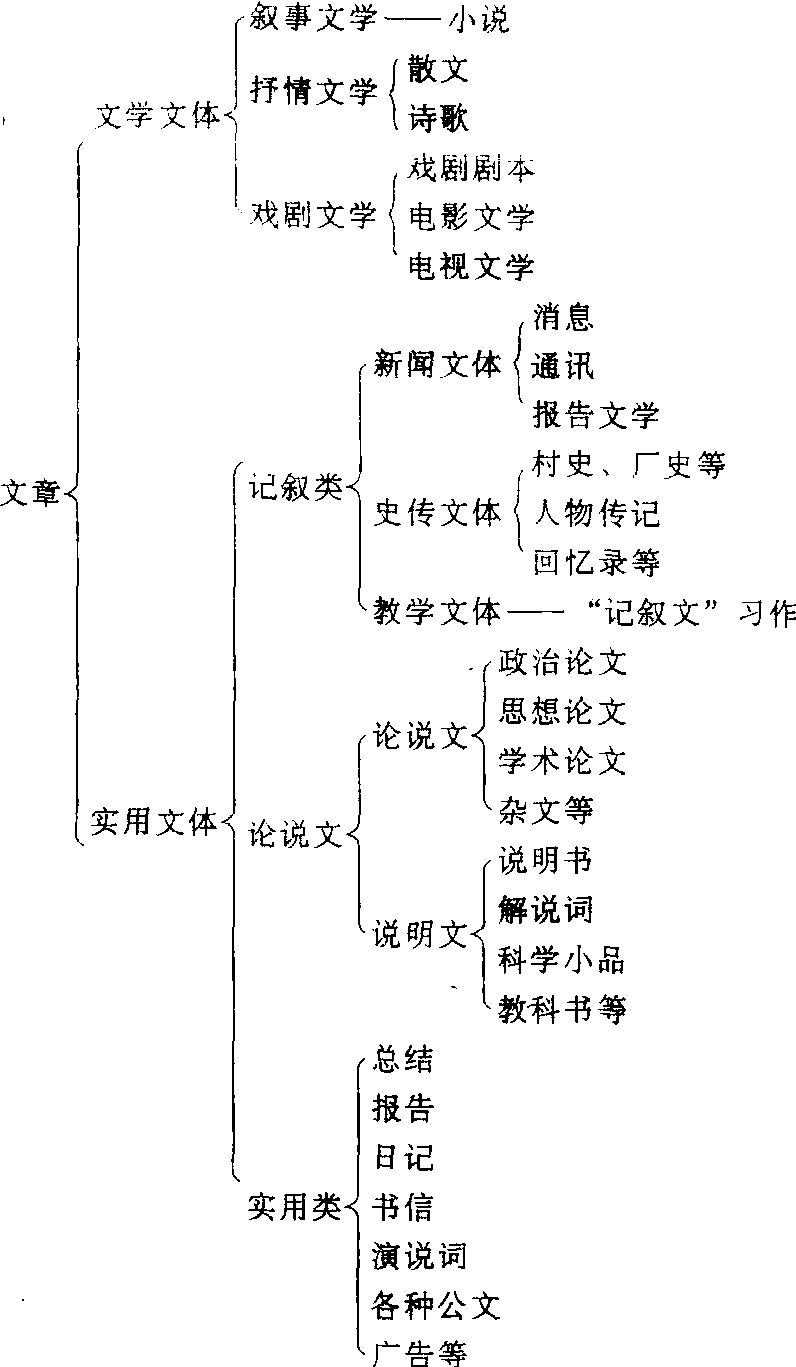文体wenti
指文章的“样式”、“样子”。文体与体裁的意义很相近,只不过“体裁”这一概念一般都特指文学作品的“样式”,而文体这一概念使用范围更宽泛一些。
在我国,最早给文章分类的是曹丕。曹丕以后“文体”划分渐趋精细,其中贡献卓越的是刘勰和萧统。刘勰在《文心雕龙》中讲了35种文体;萧统在《文选》中共分38种文体。他们对古代“文体学”的创建起了奠基的作用,对后世影响极大。
现代文章的文体分类在“五四”白话文兴盛之后,陈望道在《作文法讲义》(1922年)里,开始把文章分为记载文、记叙文、解释文、论辩文和诱导文等5大类。稍晚一点,叶圣陶在《作文论》(1924年)中,又将所有的文章分为三种:即叙述文、议论文和抒情文。这些分法都不够完善。到以后,蒋伯潜、蒋祖怡在《体裁与风格》中,比较明确地把文章分成了议论、说明、记叙、描写、抒情等五类,比较以前的划分有了明显的进步。
直至目前,似乎仍无令人满意的文体划分。这是因为各种文体的消长变化是很明显的。它们在不断地“流动”,互相影响、渗透,情况较为复杂。
现在一般对文体的“分类”,如用图显示,概要如下:

文体Wenti
文章的“样式”、“样子”, 它与体裁的意义很相近,但体裁一般专用于文学作品,而文体则泛用于各类文章。在我国,最早给文章分类的,是三国时魏国的曹丕,以后又有刘勰、萧统等人对文体的划分做过研究。但由于文章是随社会的发展而不断变化的,文章的体式也在不断地发生变化,因此至今对文体仍无一个令人满意的划分。现在一般通用的对文体的分类, 可用下面的图概略地表示:

文体
文章的体裁,即文章或文学作品的体式。文体一般分为三种:(1)记叙文。它是以写人、叙事、状物为主要内容,以叙述或描写为表达方式的文章。它包括时间、地点、人物、事件、原因和结果六个要素。如方纪的 《挥手之间》,记叙1945年延安机场送毛泽东赴重庆与国民党反动派谈判的场面,记叙中穿插议论和抒情,真切地体现了毛泽东大无畏的革命气概。狭义的记叙文指以真人真事为主要内容的文章,如新闻、特写、报告文学、回忆录、传记、游记等,广义的还包括记叙性散文、小说等文学作品。(2)议论文。它是以议论为主要表达方式的一种文章体裁 。任何一篇议论文,都必须具有论点,并运用论据,进行论证,因此,论点、论据、证论便是构成议论文的 三个要素。小学语文教材中的《为人民服务》,中学语文教材中的《谈骨气》、《放下包袱,开动机器》等文章就是议论文。议论文由于所表达的内容、形式等的不同,又可分为社论、专论、评论、杂文、论文、读后感等种类。(3)说明文。凡是用说明作为主要表达方式,来说明某个事物的形状、性质、功能或形成的原因、发生发展的过程等,阐明一种道理,给人 一定知识的,人们就称它为说明文。如中学教材中的 《向沙漠进军》、《蜘蛛》 都是说明文。说明性、知识性、客观性是说明文区别于其他文体的特点。关于文体的分类,目前分歧很大。这里只是按照通常较为普通的认识,介绍了三种文体注意,有人把 “文体” 作为 “语体” 或 “风格” 的代称,是不合适的。
文体
文体
即“语体”。
文体
❶指文章的风格体制。它决定于文学所反映的内容,由语言、结构、表现手法、文学技巧等形式因素构成,具有时代的、社会的、个人的特色,如文学史上的建安体、齐梁体、吴均体、元白体等。
❷指文章的表达方式及规格与程式,即文学体裁。就散文说,从表达方式分,有叙事体、说明体、议论体、抒情体等,就应用场合、书写程式分,有公文、社会交际应用文等。文体一旦形成,有相对的稳定性、独立性。各种文体,都有自己的构成要素,是约定俗成,必须遵守的。《昭明文选》把文体分为39类。《文苑英华》、姚铉《唐文粹》、吕祖谦《宋文鉴》、苏天爵《元文类》、程敏政《明文衡》均沿用其分类方法。吴讷《文章辨体》、徐师曾《文体明辨》分类更繁,竟达150体。姚鼐《古文辞类纂》分为13类,曾国藩又改为11类。一般地说,文体分为散文、韵文两体。散文体包括:论辨类(论、辨、难、议、说、解、释、原、对、问、喻),序记类(序、后序、送序、赠序、寿序,记、纪事、志、述、传、行状),诏令类(诰、誓、令、诏、制、敕、谕、玺书、口宣、策、策问、御札、批答、赦文、九锡、铁券文),奏疏类(奏、疏、上书、章、表、对策、射策、进策、帖括、札子、笺、启、封事、弹文、状、露布),题跋类(题、书后、跋、引、例言、读),书牍类(书、简札、帖、牍、扃、移、书、檄),碑碣类(碑、墓碑、碑颂、神道碑、碣、墓碣、碣颂、墓表、阡表、殡表、灵表、神道表、墓志、圹志、权厝志、归志、祔迁祔志、盖石文、坟版文、墓版文);韵文体包括:谣谚(谣、讴、诵、谚),箴铭(箴、铭、戒、规),颂赞(颂、赞、符命文),哀吊(哀辞、哀策文、吊文、诔),祝祭(祝辞、祭文、盟辞、誓辞、嘏辞、玉牒文、上梁文、醴辞、醮辞、字辞),诗赋(诗、歌、乐府、歌行),辞骚(赋、骚、辞、七),连珠,词。